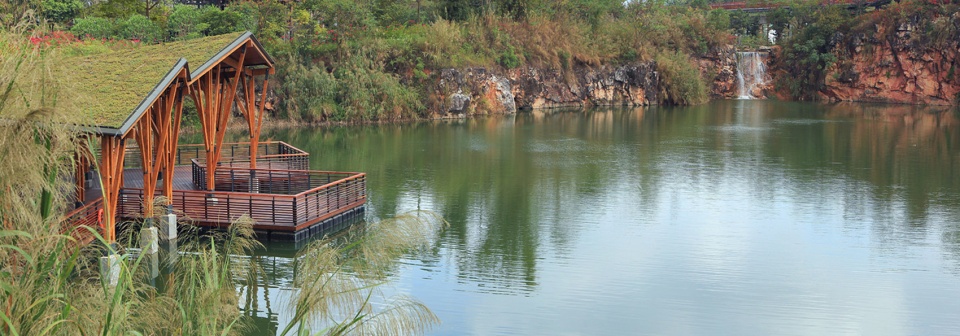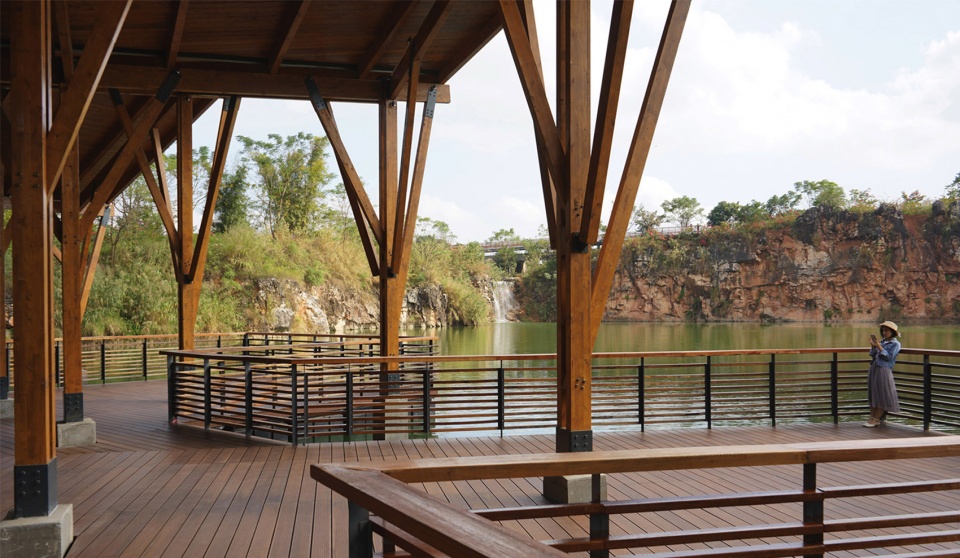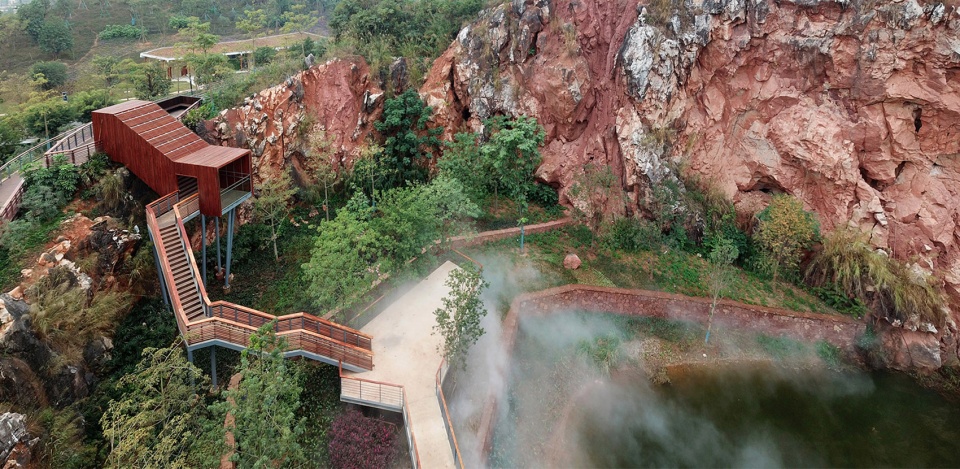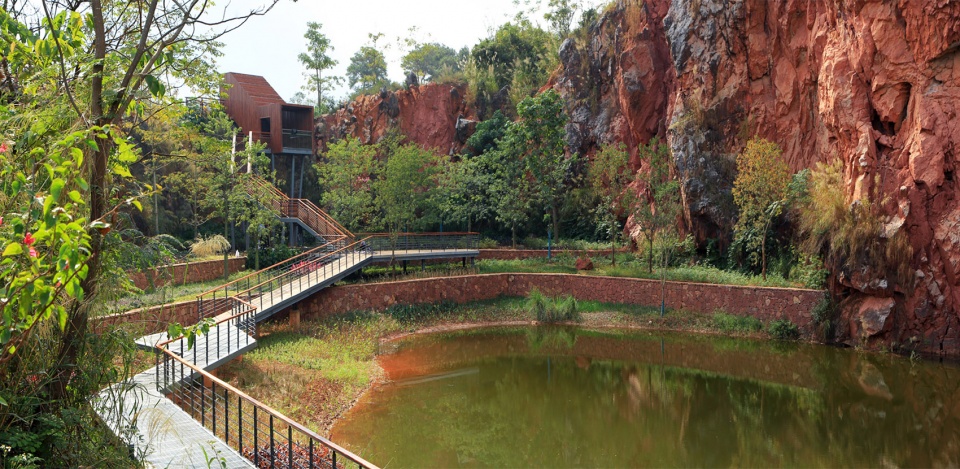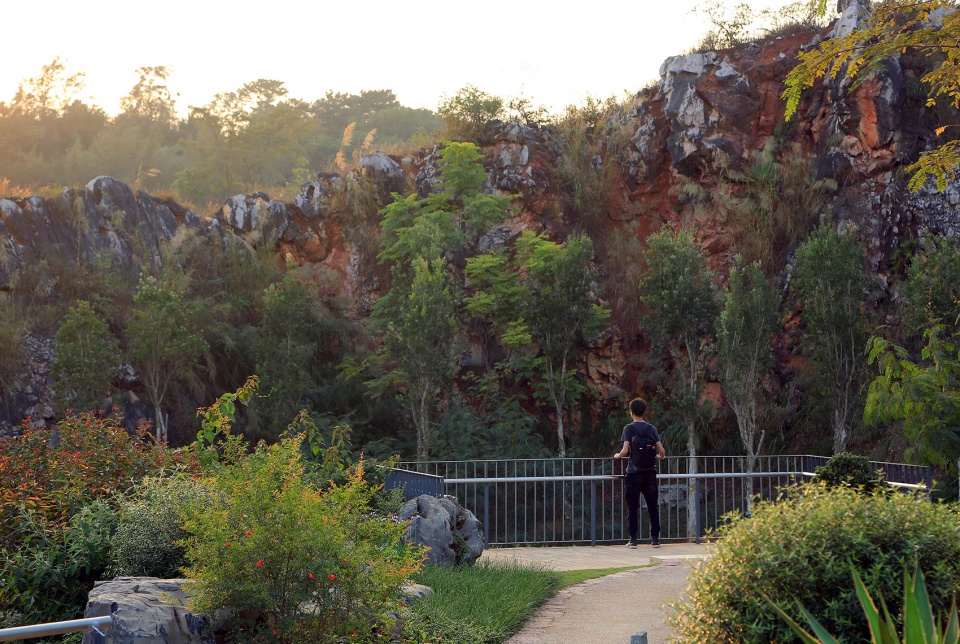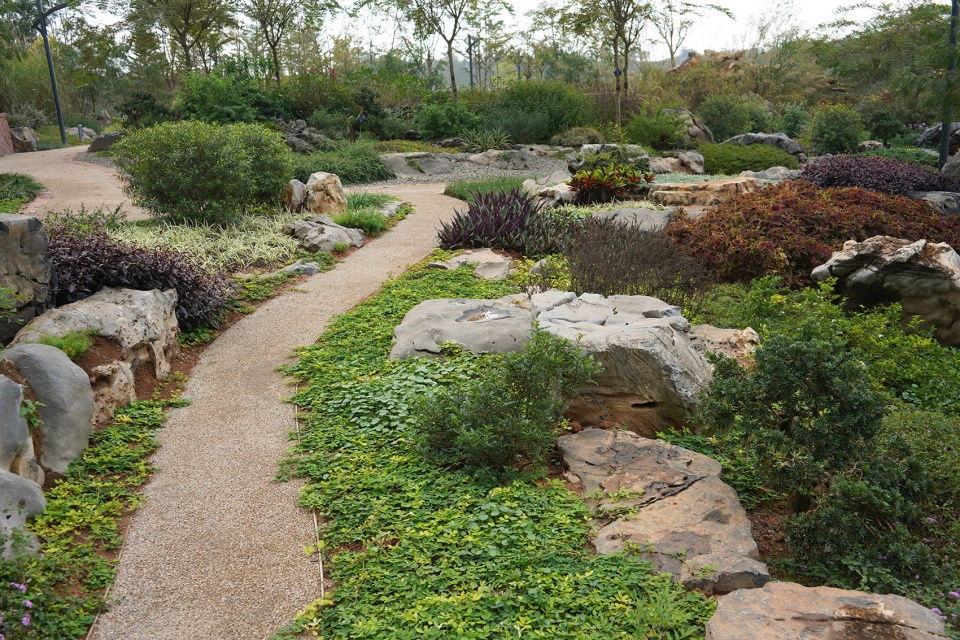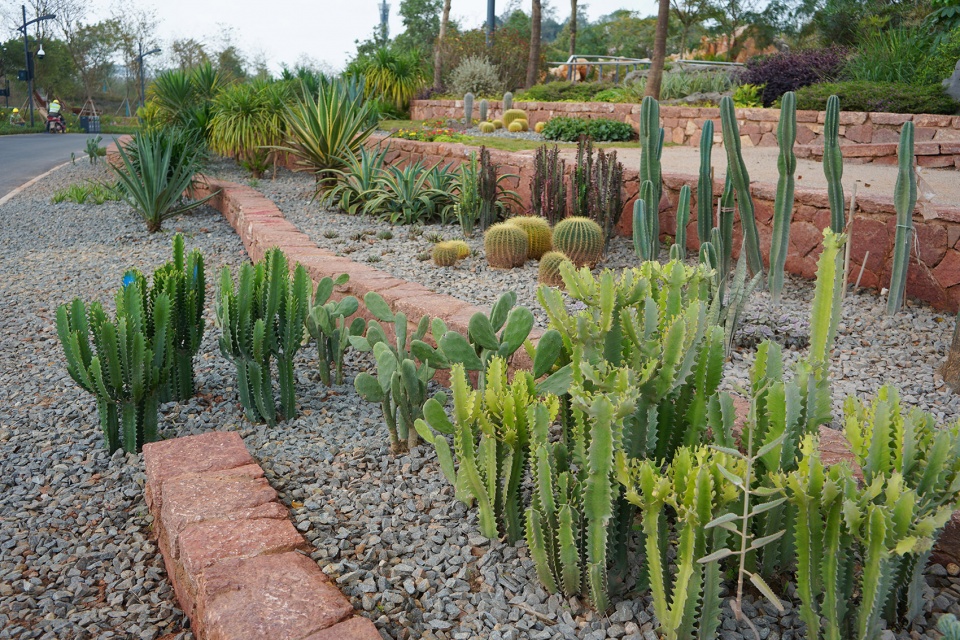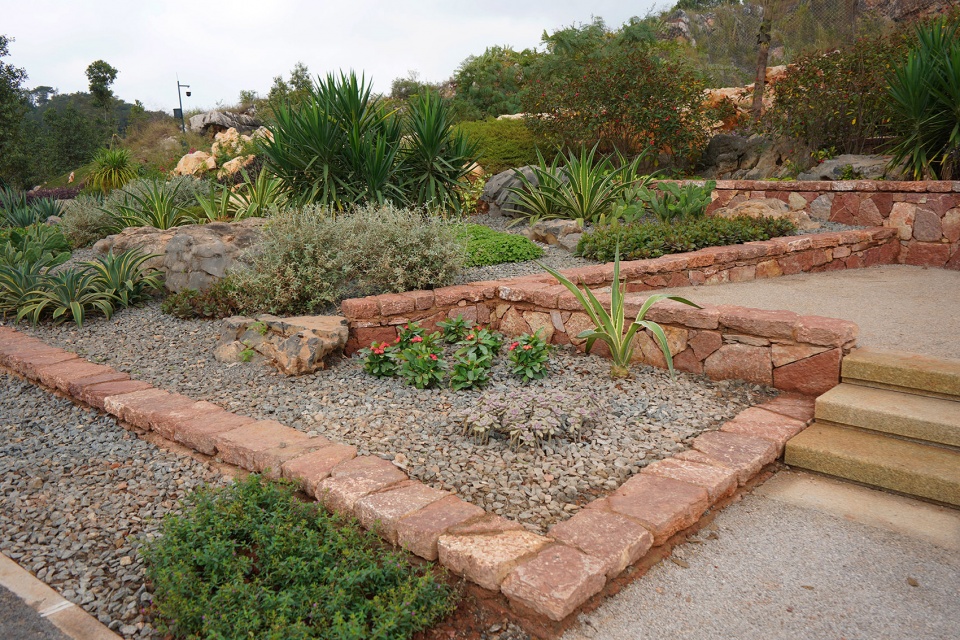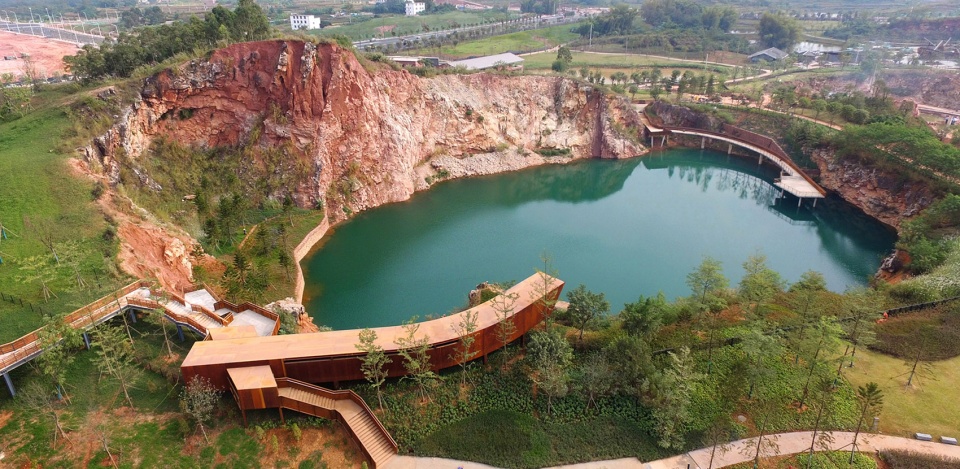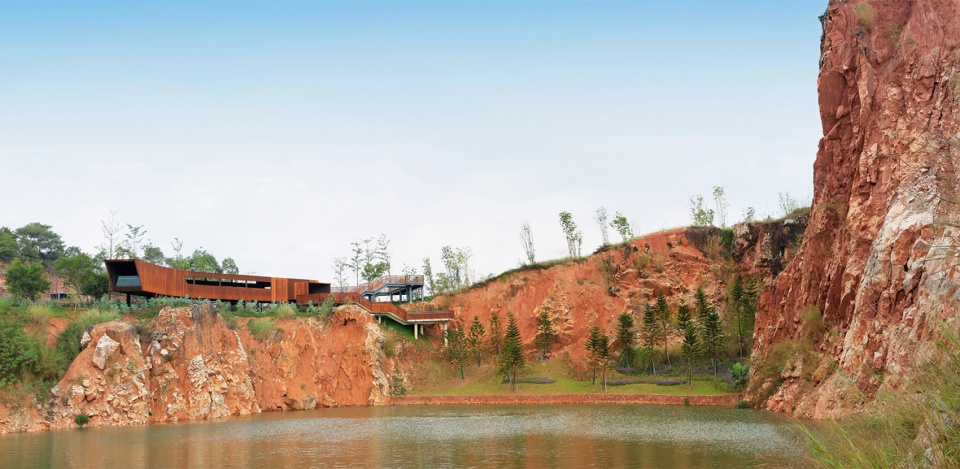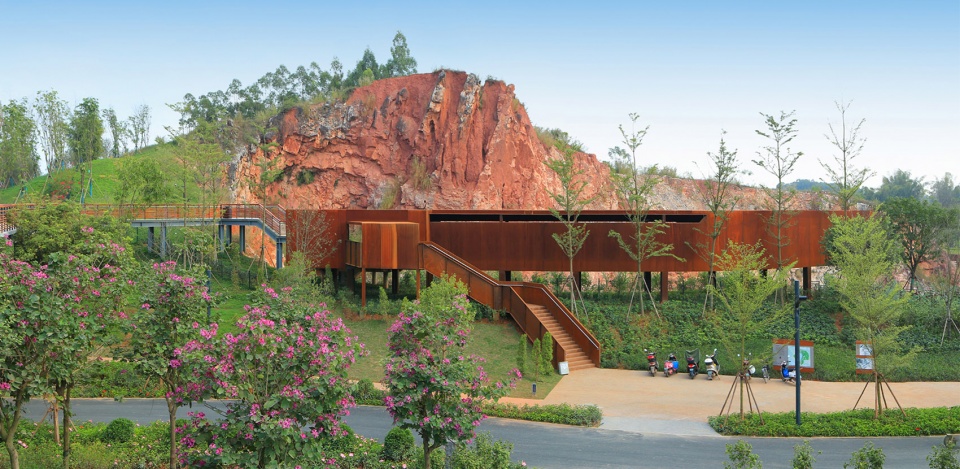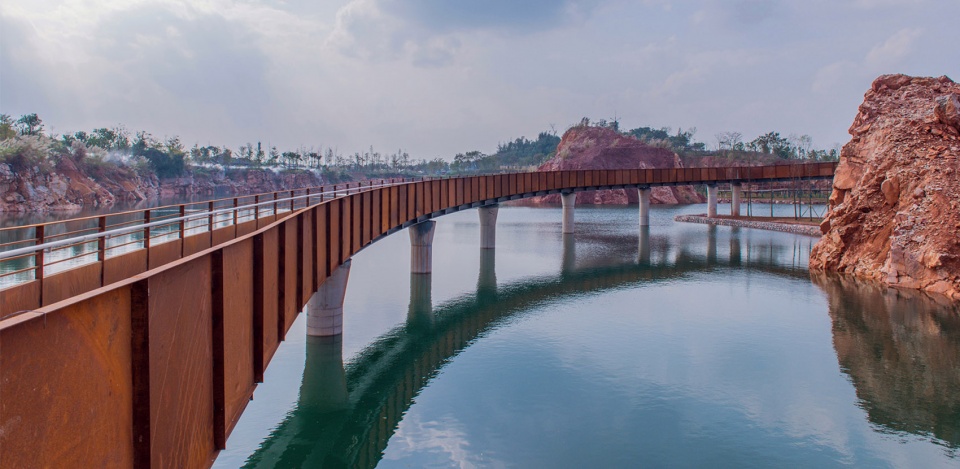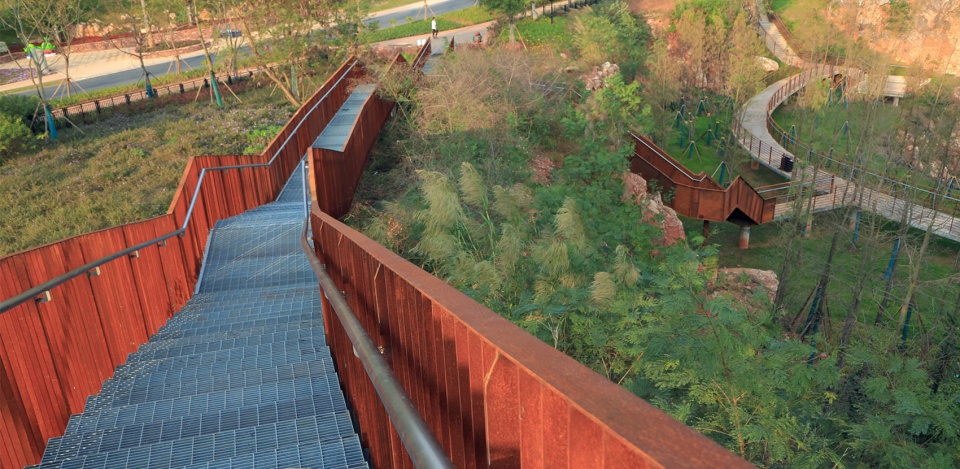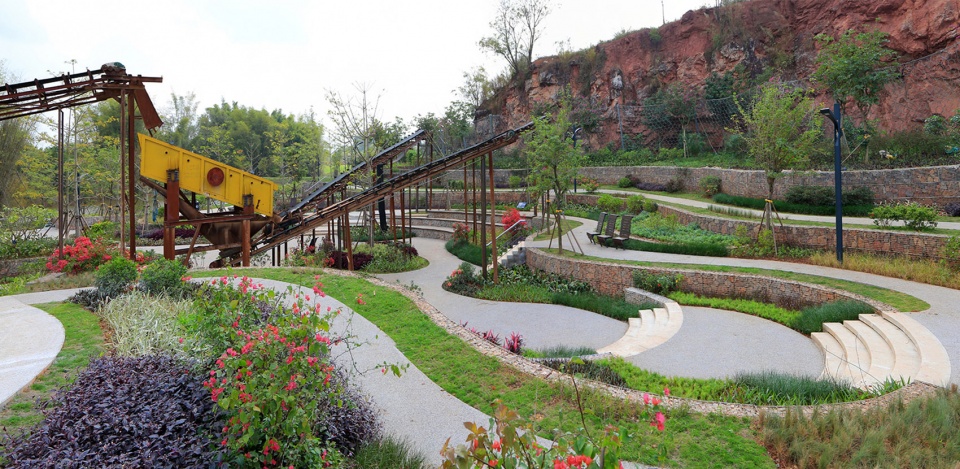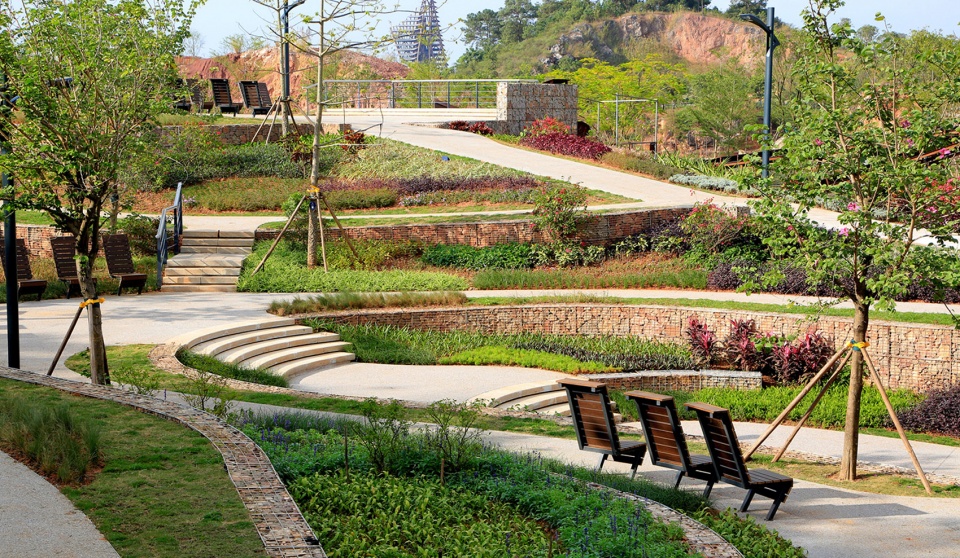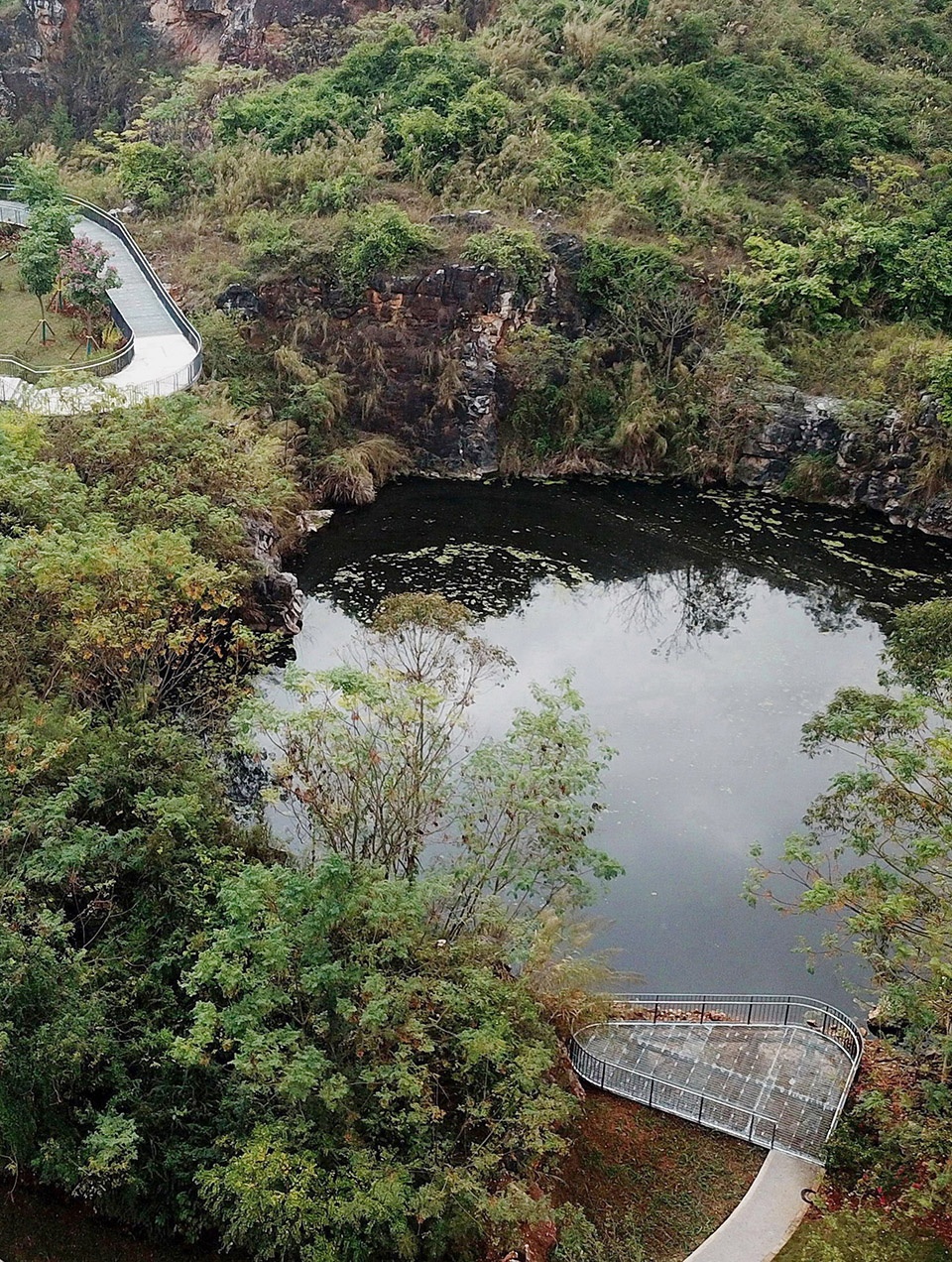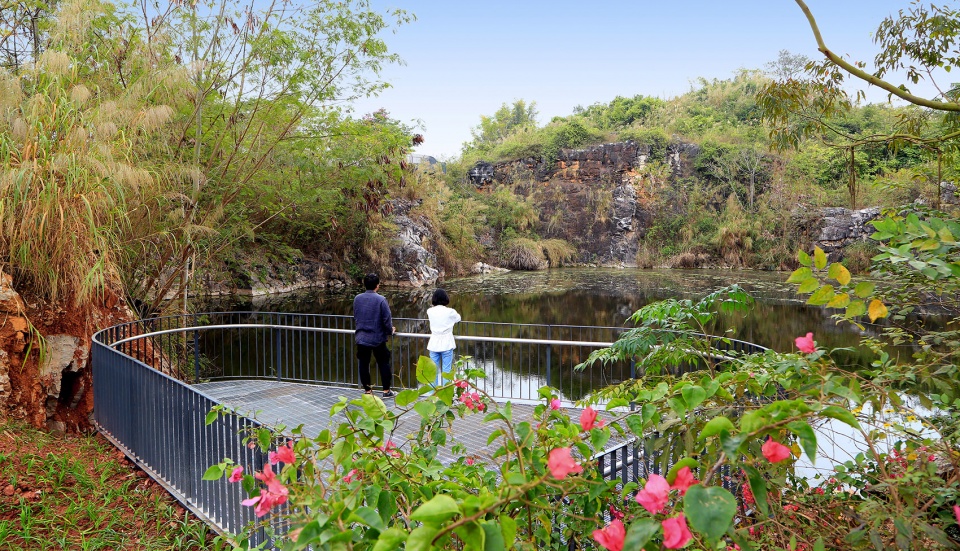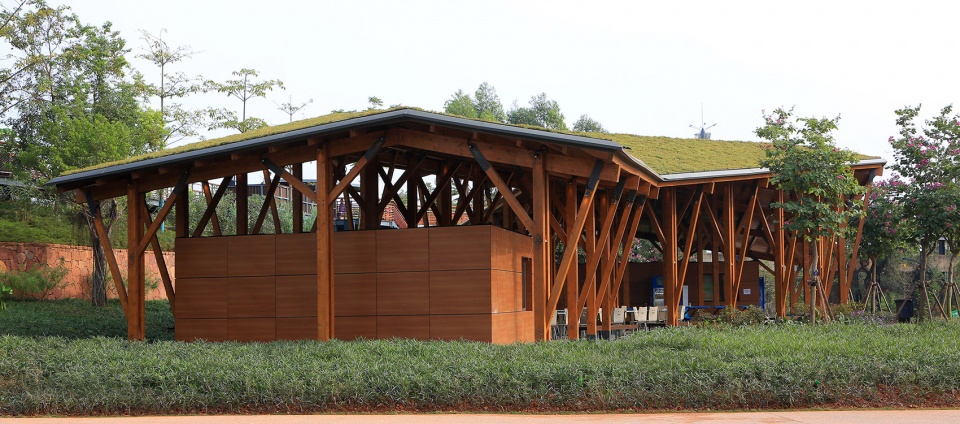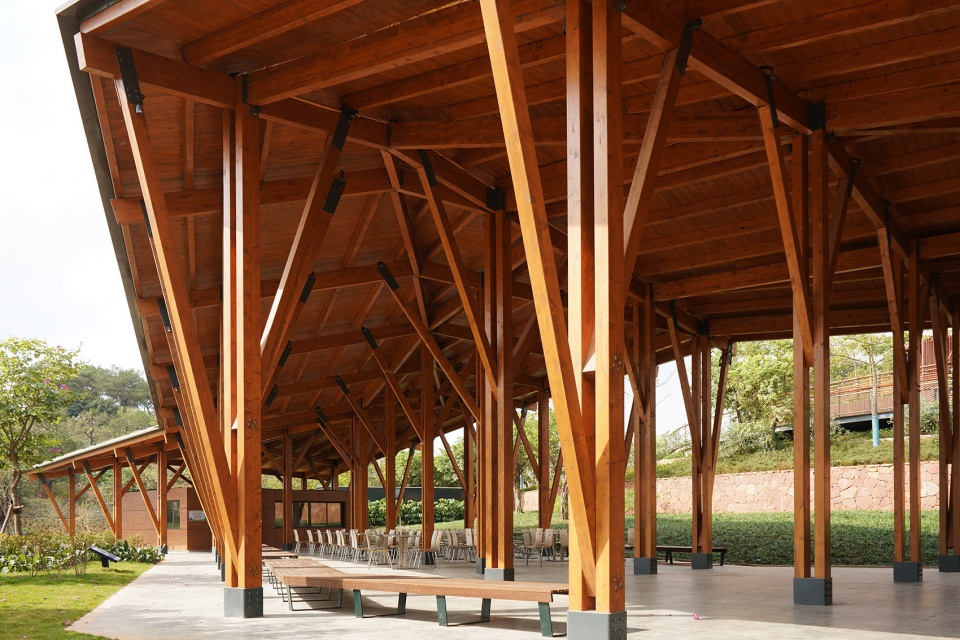感謝 北(běi)京多義景觀規劃設計(jì)事務(wù)所 予gooood分享以下內(nèi)容。 更多關于他(tā)們:ATELIER DYJG on gooood
Appreciations towards ATELIER DYJG for providing the following description:
2018年中國國際園林(lín)博覽會(huì)在(zài)南甯市(shì)舉辦。園博園選址于城市(shì)郊區(qū)的(de)一片濱河(hé)(hé)的(de)丘陵農業區(qū),但(dàn)場地(dì)東南區(qū)域分布著(zhe)一系列的(de)采石場。組委會(huì)希望将這(zhè)些采石場轉變為(wèi)園林(lín)博覽會(huì)中的(de)有特色的(de)園林(lín),成為(wèi)展覽的(de)一部分。設計(jì)面積約33公頃。場地(dì)上共7個(gè)采石場,有的(de)已停采了幾年,有2個(gè)直到園博會(huì)申辦成功時才停止開采。由于開采采用(yòng)的(de)是爆破方式,因此開采面崖壁破碎,坑底高(gāo)低不(bù)平。采石場留下的(de)是破碎的(de)丘陵,高(gāo)聳的(de)懸崖,荒蕪的(de)地(dì)表,深不(bù)見底的(de)水(shuǐ)潭,成堆的(de)渣土(tǔ)渣石,和生鏽的(de)采石設備。
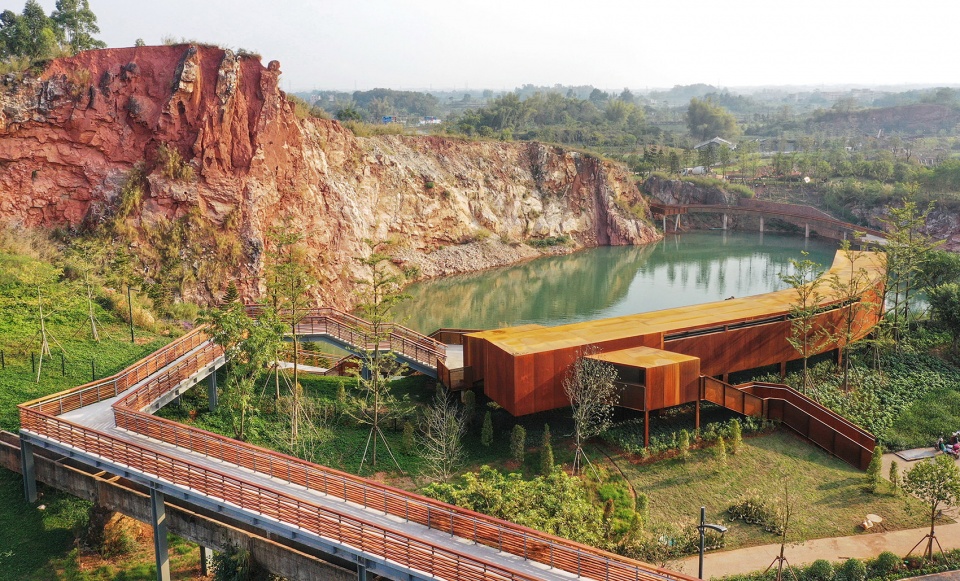
設計(jì)面臨著(zhe)一系列巨大的(de)挑戰:采石場地(dì)質情況複雜,岩壁破碎,有崩塌落石的(de)可能,有不(bù)可預知的(de)安全隐患;采石場生态環境破壞嚴重,植被的(de)修複面臨很大挑戰;采石坑的(de)地(dì)貌極其複雜,無法依據現狀測繪圖紙(zhǐ)進行(xíng)設計(jì);采石坑的(de)水(shuǐ)位一直在(zài)變化(huà)(huà),尤其是最後停采的(de)2個(gè)采石場,水(shuǐ)位一直在(zài)持續上升。設計(jì)沒有有效的(de)水(shuǐ)文數(shù)據。
為(wèi)了精确地(dì)開展設計(jì),設計(jì)師(shī)通過無人機航拍(pāi)掃描,得到所有采石場的(de)三維數(shù)字模型,設計(jì)得以從始至終在(zài)三維空間上進行(xíng)。設計(jì)師(shī)還委托當地(dì)機構每半個(gè)月記錄一次每個(gè)坑中水(shuǐ)位變化(huà)(huà)的(de)情況,為(wèi)設計(jì)提供依據。同時,設計(jì)師(shī)根據不(bù)同采石場植被恢複的(de)目标,引入土(tǔ)壤,形成不(bù)同土(tǔ)壤厚度的(de)種植區(qū)域,為(wèi)恢複生境創造條。在(zài)設置設施和參觀路(lù)徑的(de)時候将安全性放在(zài)首位,在(zài)突出采石場景觀特色的(de)同時避讓危險區(qū)域。7個(gè)采石場看起來很相似,但(dàn)實際上每個(gè)的(de)尺度、形态和特征都不(bù)相同。針對不(bù)同的(de)場地(dì)特征,設計(jì)采用(yòng)了差異化(huà)(huà)的(de)植被修複方法和人工介入方式。
1号采石場(落霞池)
Quarry No. 1
這(zhè)個(gè)面積約1hm²的(de)采石場,由于停采之後地(dì)下水(shuǐ)滲出,形成了一個(gè)由岩石包圍的(de)甯靜(jìng)池塘,被附近(jìn)村民用(yòng)于養魚。環繞池塘的(de)石壁雄渾厚重,非常符合中國傳統藝術對岩石的(de)審美。設計(jì)試圖體現中國傳統的(de)風景美學(xué)。一個(gè)不(bù)規則形狀的(de)木結構建築被嵌入池塘邊緣的(de)岩石豁口中,其結構形式從當地(dì)的(de)鄉土(tǔ)建築中獲得靈感。
Quarry No. 1 is a one-hectare quiet pond walled within a rough rock hedge, in which China’s traditional landscape aesthetics is attempted to be embodied. A wooden and irregularly-shaped pavilion is nestled within a rock gap at the edge of a pond, whose structural form is inspired by the local vernacular architecture.
▼景觀要素呈現出中國傳統的(de)詩意的(de)風景美學(xué),landscape elements well-depict the China’s traditional poetic landscape aesthetics © 北(běi)京多義景觀規劃設計(jì)事務(wù)所
從陸地(dì)到水(shuǐ)面,建築從狹長(cháng)的(de)廊子(zi)轉變為(wèi)水(shuǐ)邊的(de)大亭子(zi)。為(wèi)适應水(shuǐ)位的(de)變化(huà)(huà),亭子(zi)的(de)地(dì)闆是浮動的(de)。遊客在(zài)這(zhè)裡(lǐ)可以欣賞對面的(de)岩壁和瀑布。瀑布為(wèi)這(zhè)個(gè)采石坑增加了景觀的(de)動态變化(huà)(huà),潺潺的(de)水(shuǐ)聲增添了甯靜(jìng)悠遠(yuǎn)的(de)氣氛。水(shuǐ)岸的(de)一條小徑聯系了4處不(bù)同标高(gāo)的(de)平台,為(wèi)人們提供了從不(bù)同的(de)角度觀賞岩石、瀑布和建築的(de)場所。水(shuǐ)邊岩石上種滿了紅色的(de)三角梅,懸垂下來,倒影在(zài)池塘中。
It provides visitors with a panorama of green pond and encircling cliff, and babble waterfall on the diagonal opposite. To adapt to the unstable water levels, the pavilion floor is designed floated. A waterfront path links four platforms with varying elevations, offering people with all-round perspectives to enjoy the scenery.
▼亭子(zi)的(de)結構形式從當地(dì)的(de)鄉土(tǔ)建築中獲得靈感,the structural style of the pavilion is inspired by vernacular architecture © 北(běi)京多義景觀規劃設計(jì)事務(wù)所
2号采石場(水(shuǐ)花(huā)園)
Quarry No. 2
采石場面積僅為(wèi)0.4 hm²,四周岩壁環繞,坑底較平緩,低處常年有積水(shuǐ),是周圍村莊鴨子(zi)嬉戲的(de)樂園。它被設計(jì)成為(wèi)一個(gè)濕生植物(wù)花(huā)園。覆土(tǔ)形成的(de)緩坡從淺水(shuǐ)區(qū)一直延伸至岸上,種植了40多種水(shuǐ)生和濕生植物(wù)。在(zài)地(dì)勢較高(gāo)處設計(jì)了兩層台地(dì),種植喬灌木,為(wèi)花(huā)園創造了背景,也遮擋了破碎的(de)岩壁。山崖上方有路(lù)徑與采石坑底部連接,最高(gāo)的(de)一段是封閉的(de)木盒,既是安全的(de)步行(xíng)通道(dào),也是一個(gè)空中觀景台,人們可在(zài)此欣賞岩壁,俯瞰花(huā)園。木盒下方有一個(gè)寬大的(de)平台,平台引出的(de)之字形鋼格栅棧道(dào)從濕生植物(wù)種植區(qū)穿過。
Quarry No. 2 is surrounded by cliffs on all sides,with an area of only 0.4 ha. The quarry bottom is relatively flat and accumulates water perennially. The quarry is designed as an aquatic garden. The zigzag steel grating walkway winds through the planting zone and connects to a platform that further extends to a path above the cliff, accessed by several flights of steps. The section with the highest elevation features a closed wooden box, which is also an aerial viewing platform where people can appreciate a captivating view of the cliff and the entire garden expanse.
▼2号采石場被設計(jì)成濕生植物(wù)花(huā)園,the quarry was transformed as an aquatic plant garden © 北(běi)京多義景觀規劃設計(jì)事務(wù)所
▼一條路(lù)徑連接了山崖上方的(de)水(shuǐ)渠棧道(dào)與采石坑底部的(de)平台,a path connects cliff-top to the platform at the pit-bottom © 北(běi)京多義景觀規劃設計(jì)事務(wù)所
3号采石場(岩石園)
Quarry No. 3
這(zhè)個(gè)0.4hm²采石場基址呈碗狀,三面環繞岩壁,一側地(dì)面堆放了大量渣石和渣土(tǔ)。受到岩石縫隙中萌發的(de)植物(wù)的(de)啟發,我(wǒ)們将這(zhè)個(gè)采石場設計(jì)為(wèi)精緻的(de)岩石園。設計(jì)将原有的(de)渣石渣土(tǔ)整理(lǐ)後塑造出地(dì)形的(de)骨架,然後在(zài)上面覆蓋種植土(tǔ)。微妙的(de)地(dì)形變化(huà)(huà)不(bù)僅創造出幹燥和濕潤等不(bù)同的(de)生境,為(wèi)不(bù)同植物(wù)生長(cháng)提供條件(jiàn),也把場地(dì)雨水(shuǐ)收集到最低的(de)凹陷區(qū)。
Quarry No. 3 is bordered by the cliff on three sides and was designed as a delicate rock garden. The abandoned soil and gravel on site were utilized as the base of the garden’s subtle landform, with planting soil wrapping its surface. A moderately-sized terrace garden is designed near the main road, creating a unique desert plant landscape.
▼采石場基址呈碗狀,三面環繞岩壁 ,Quarry No. 3 is bordered by the cliff on three sides and was designed as a delicate rock garden © 北(běi)京多義景觀規劃設計(jì)事務(wù)所
緊鄰主園路(lù)設計(jì)了幾層尺度親切、變化(huà)(huà)豐富的(de)台地(dì)來化(huà)(huà)解高(gāo)差。台地(dì)上種植了仙人掌和多肉多漿等沙生植物(wù),營造出極富特色的(de)沙漠植物(wù)景觀。中間緩坡區(qū)展現荒原植物(wù)景觀。底部凹陷區(qū)被設計(jì)為(wèi)濕生岩石園,有溪流層層跌落至最低處的(de)池塘。兩個(gè)标高(gāo)不(bù)同的(de)平台位于凹陷區(qū)的(de)邊緣,人們可以憑欄觀賞溪流跌水(shuǐ)。
The gentle-sloping section in the center consists of a dry garden, while the southern concave section showcases hygrophilous rock plants with water cascading into the lowest pond. Two platforms with different elevations are constructed at the edge of the concave area, where people can enjoy a charming view of the garden.
▼采石場設計(jì)為(wèi)精緻的(de)岩石園, delicate rock garden © 北(běi)京多義景觀規劃設計(jì)事務(wù)所
▼變化(huà)(huà)豐富的(de)台地(dì)與沙漠植物(wù)景觀, moderately-sized terrace garden and desert plant landscape © 北(běi)京多義景觀規劃設計(jì)事務(wù)所
4号采石場(峻崖潭)
Quarry No. 4
采石場停采之後滲透出來的(de)地(dì)下水(shuǐ)彙成一個(gè)面積約1hm²的(de)碧綠澄澈的(de)大水(shuǐ)潭。我(wǒ)們在(zài)南北(běi)兩側主要觀賞點設置了平台。北(běi)側的(de)觀景台是一個(gè)位于采石場邊緣的(de)耐候鋼長(cháng)廊,內(nèi)部朝向采石場打開了一長(cháng)條帶形窗,在(zài)此可以望見對面高(gāo)出水(shuǐ)面40多米的(de)高(gāo)聳險峻的(de)懸崖。長(cháng)廊南端懸挑在(zài)岩壁上,人們站在(zài)玻璃欄杆內(nèi)側可以俯瞰腳下的(de)一池碧水(shuǐ)和對面的(de)濱水(shuǐ)平台,驚險刺激。
Quarry No. 4 is a large pond embraced by cliffs, with green and clear water. Viewing platforms sit on both northern and southern sides of the quarry. The northern platform is a Corten steel corridor located at the quarry’s edge, unraveling a long strip window towards the quarry, where visitors can feast their eyes on the steep cliff towering over 40 meters above the water surface. At the southern end of the corridor, people can enjoy an overlooking view of the charming pond situated beneath and the waterfront platform on the opposite side, offering a thrilling and exciting experience.
▼4号采石場俯瞰 ,aerial view of the quarry no.4 © 北(běi)京多義景觀規劃設計(jì)事務(wù)所
采石坑南側,一個(gè)楔形平台從山石的(de)一個(gè)豁口探出,懸挑于碧水(shuǐ)之上,一條曲線的(de)棧橋從平台引出,連接低處的(de)濱水(shuǐ)平台。坑體周圍和和坑內(nèi)緩坡處通過覆土(tǔ),種植了南洋杉和一些鄉土(tǔ)灌木及草本,使采石場有了生機并襯托出崖壁的(de)險峻。
On the southern side of the quarry, a wedge-shaped platform stretches out from a gap among the rocks. It hangs above the waters and connects to the lower waterfront platform through a curved bridge. Through an earthing-up process, vegetation was restored around the quarry as well as the gentle slope inside, which revives the quarry garden meanwhile highlights the steepness of cliffs.
▼采石坑北(běi)側的(de)高(gāo)處的(de)長(cháng)廊和南側低處的(de)棧橋和平台,The higher corridor on the north side of the quarry and the lower boardwalk with platform on the south © 北(běi)京多義景觀規劃設計(jì)事務(wù)所
▼懸于峭壁之上的(de)耐候鋼長(cháng)廊,the Corten steel corridor on the edge of the quarry © 北(běi)京多義景觀規劃設計(jì)事務(wù)所
5号采石場(飛瀑湖)
Quarry No. 5
這(zhè)個(gè)面積最大的(de)采石場約3.2hm²,開采深度也最深,達28m,底部呈現幾層岩台,崖壁破碎。随著(zhe)地(dì)下水(shuǐ)逐漸蓄積,水(shuǐ)位不(bù)斷上升。根據水(shuǐ)位觀測和分析,我(wǒ)們判斷最終整個(gè)采石坑将成為(wèi)一片湖面。設計(jì)師(shī)通過覆土(tǔ)将采石坑底部兩片開采深度相對較淺的(de)區(qū)域擡高(gāo)到水(shuǐ)面之上,并種植耐濕高(gāo)大喬木如池杉和水(shuǐ)松,形成水(shuǐ)上叢林(lín),為(wèi)荒涼的(de)坑體內(nèi)部帶來綠色和生機。然後用(yòng)不(bù)同高(gāo)度的(de)棧橋引導人們進入采石坑內(nèi)部,穿越水(shuǐ)面和樹(shù)林(lín),通往岬角高(gāo)處的(de)觀景台,在(zài)下降和攀登的(de)探索中體驗空間和景觀的(de)變化(huà)(huà)。為(wèi)了增加景觀的(de)豐富性,棧橋對面的(de)崖壁上設計(jì)了飛流而下的(de)瀑布,人們可以在(zài)橋上觀賞到精彩的(de)瀑布景觀。
Quarry No. 5 is the largest among the seven quarries, enclosed by dilapidated cliff with terraced rocks sitting at the bottom. The quarry has transformed into a lake, caused by the continuously-rising water level. Two areas with relatively shallow mining depths were earthed up above the water surface, and planted with trees such as pond cypress and Chinese cypress, creating an aquatic woods landscape. Bridges and walkways of varying heights crisscross above the water and through the woods, creating a connection with the hilltop view platform. A waterfall is designed on the opposite of the bridge, forming a scenery spot accordingly.
▼不(bù)同高(gāo)度的(de)棧橋引導人們進入采石坑內(nèi)部 ,bridges and walkways of varying heights crisscross above the water © 北(běi)京多義景觀規劃設計(jì)事務(wù)所
▼棧道(dào)通往山坡高(gāo)處的(de)觀景台,the Corten steel path leading to the viewing platform at the hilltop © 北(běi)京多義景觀規劃設計(jì)事務(wù)所
6号采石場(台地(dì)園)
Quarry No. 6
6号采石場一側是采石場崖壁,一側是鄉村水(shuǐ)塘,面積為(wèi)0.7hm²。場地(dì)上有制砂生産線的(de)全套設備,展現著(zhe)場地(dì)采石工業的(de)曆史。它被塑造成具有後工業氣氛的(de)浪漫絢麗(lì)的(de)花(huā)園。幾層台地(dì)沿南側崖壁蜿蜒展開,它們的(de)覆土(tǔ)厚度滿足不(bù)同植物(wù)生長(cháng)的(de)需要。機械設備大部分被置于綠地(dì)之中,生機勃勃的(de)植物(wù)與鏽迹斑斑的(de)機械形成有趣的(de)對比。道(dào)路(lù)在(zài)不(bù)同高(gāo)度的(de)台地(dì)中和原有高(gāo)架傳送帶下方曲折穿過,路(lù)邊設置了舒适的(de)木質靠背椅供人休息。
Quarry No. 6 was transformed into a romantic and gorgeous garden with post-industrial atmosphere, utilizing sand production machines left onsite. Along the southern cliff are several terraces with various thicknesses of earthing soil, meeting the needs of various plants, from herbs to trees. Most of the leftover equipment was set in the verdant greens that contrast with the rusty machinery. The paths twist among the terraces of different heights and under the overhead conveyor belt. Wooden benches along the paths and platforms provide comfortable venues for rest and relaxation.
▼具有後工業氣氛的(de)浪漫絢麗(lì)的(de)台地(dì)花(huā)園,romantic and gorgeous terrace garden with post-industrial atmosphere © 北(běi)京多義景觀規劃設計(jì)事務(wù)所
▼不(bù)同覆土(tǔ)厚度的(de)台地(dì)滿足不(bù)同植物(wù)生長(cháng)的(de)需要,various thicknesses of earthing soil meet the needs of plants © 北(běi)京多義景觀規劃設計(jì)事務(wù)所
7号采石場(雙秀園)
Quarry No. 7
這(zhè)是位于一座小山兩翼的(de)兩個(gè)1000多平方米的(de)小采石坑,一個(gè)較深,終年有水(shuǐ);另一個(gè)較淺,有季節性積水(shuǐ)。因為(wèi)廢棄了若幹年,兩個(gè)坑的(de)石縫裡(lǐ)長(cháng)出了各種鄉土(tǔ)先鋒植物(wù),景觀樸野自然。設計(jì)沒有采用(yòng)過多的(de)人工幹預,隻在(zài)兩個(gè)坑體中間未被開采的(de)山坡上設置了一圈環形棧道(dào),讓遊人在(zài)這(zhè)裡(lǐ)俯視(shì)兩側的(de)采石坑,讓人們了解在(zài)礦坑修複中自然的(de)力量和作用(yòng)。在(zài)西側坑體邊緣設了一個(gè)臨水(shuǐ)小平台,與山上的(de)環形棧道(dào)相呼應。棧道(dào)和平台都采用(yòng)鋼格栅的(de)材料,透光透水(shuǐ),不(bù)會(huì)影響場地(dì)自然植被的(de)恢複。
Quarry No. 7 Comprises of two small quarry pits located on two sides of a hill. Abandoned for years, a variety of native pioneer plants have grown out of cracks in the rocks, displaying a natural landscape. With only a few interventions, a ring-shaped walkway skirting the hillside between two pits and a small platform on the edge of the west pit are constructed. They affords visitors a wild view , which demonstrates natural forces and functions in the restoration of quarries. Both walkway and platform adopt steel grating that transmit light and water, preserving the natural vegetation on site.
▼7号采石場概覽 – 山頂的(de)環形棧道(dào)和水(shuǐ)邊的(de)平台,overall of the Quarry No. 7:The ring-shaped walkway atop the hill and waterside platform © 北(běi)京多義景觀規劃設計(jì)事務(wù)所
通過契合場地(dì)地(dì)貌和景觀特征的(de)設計(jì),7個(gè)岩石破碎、荒涼的(de)采石場轉變成為(wèi)了園林(lín)博覽會(huì)上獨特的(de)系列花(huā)園,展現了采石場生态修複的(de)可能性和景觀藝術的(de)不(bù)同維度。它們所展現出來的(de)思想和方法,不(bù)僅僅在(zài)采石場修複項目中、并且在(zài)更廣泛的(de)景觀實踐中具有示範的(de)價值。
With the design well-fitted with its original landform and landscape features, seven dilapidated and desolate quarries have undergone a fascinating transformation into a series of unique gardens. They demonstrate the promising possibilities and showcase to the public the diversified methods of quarry eco-restoration as well as the multiple dimensions of landscape art.
▼荒涼的(de)采石場轉變成獨特的(de)系列花(huā)園 ,desolate quarries transform into a series of unique gardens © 北(běi)京多義景觀規劃設計(jì)事務(wù)所
場地(dì)上原有一道(dào)水(shuǐ)渠,是場地(dì)農業曆史的(de)見證。我(wǒ)們在(zài)設計(jì)中保留了水(shuǐ)渠,将它作為(wèi)該區(qū)域幾個(gè)水(shuǐ)面的(de)補水(shuǐ)水(shuǐ)源,延續它原有的(de)功能,并水(shuǐ)渠上方架設高(gāo)架步行(xíng)橋,與相臨的(de)采石場花(huā)園的(de)遊覽路(lù)徑連接起來,形成該區(qū)域獨特的(de)立體遊覽體系。為(wèi)了給遊客提供一些基本服(fú)務(wù),同時也展示園區(qū)生态修複的(de)理(lǐ)念和方法,我(wǒ)們在(zài)采石場區(qū)域設計(jì)了一個(gè)600m²的(de)信息亭。木結構的(de)建築呼應了當地(dì)鄉土(tǔ)建築的(de)形式。
An existing aqueduct runs across the site, transporting water from nearby spring to surrounding villages and farms. As a witness of site’s agricultural history, it is well-preserved for irrigation water supply of the area, retaining its original function. Above the aqueduct is a pedestrian bridge that connects to the paths toward the adjacent quarry gardens, creating a unique three-dimensional tour system in this area. A 600m2 pavilion provides various tourist services such as sales, rest, shuttle bus ticketing, etc., and also showcases the history and eco-restoration processes and methods of the quarry gardens.
▼木結構的(de)信息亭,pavilion with wooden structure © 北(běi)京多義景觀規劃設計(jì)事務(wù)所
▼信息亭細部,details of the pavilion © 北(běi)京多義景觀規劃設計(jì)事務(wù)所





